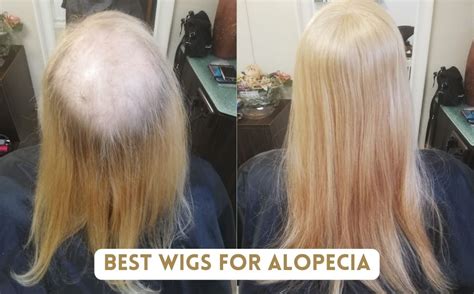Alopecia, a condition that leads to hair loss, affects millions worldwide. Wigs offer a discreet and effective means of managing its impact on appearance. Understanding the complexities of wig selection for alopecia empowers individuals to make informed decisions.

Types of Wigs for Alopecia
Wigs come in various types, each catering to specific needs:
- Synthetic wigs: Made from artificial fibers, they are affordable, widely available, and easy to maintain.
- Human hair wigs: Crafted from real human hair, these offer a natural look, versatility in styling, and extended durability.
- Lace wigs: Utilize a sheer lace base that gives the illusion of scalp, allowing for a seamless blend with natural hair.
- Monofilament wigs: Employ a fine mesh base that mimics the scalp, providing a lightweight and breathable fit.
Factors to Consider
When selecting a wig for alopecia, consider these crucial factors:
- Nature of Alopecia: The type of alopecia (e.g., androgenetic, alopecia areata) influences wig design and attachment methods.
- Scalp Condition: Sensitive or irritated scalps may require wigs made from breathable materials or with hypoallergenic adhesives.
- Hair Replacement Goals: Determine whether the wig is intended for full head coverage or partial concealment.
- Lifestyle: Active lifestyles may necessitate wigs with secure attachment systems and low maintenance requirements.
- Aesthetic Preferences: Personal preferences dictate the wig’s color, texture, length, and styling options.
Benefits of Wigs for Alopecia
Wigs for alopecia offer numerous advantages:
- Concealment: Effectively hide hair loss, restoring a sense of confidence and well-being.
- Protection: Shield the scalp from sun exposure, physical irritation, and other environmental factors.
- Volume and Style: Add volume and allow for various hairstyles, enabling customization according to individual tastes.
- Emotional Support: Can enhance self-esteem and reduce the psychological impact of hair loss.
Market Statistics and Trends
- As per the American Hair Loss Association, around 40% of women and 50% of men experience significant hair loss by age 50.
- The global wig market is projected to reach $13.6 billion by 2027, driven by rising awareness about alopecia and advancements in wig technology.
- Lace wigs and human hair wigs have experienced increasing popularity due to their natural appearance and durability.
How to Choose the Right Wig
- Consult a Hair Loss Specialist: Seek professional guidance to determine the best wig option for individual needs and preferences.
- Measure Head Size and Hair Loss Area: Accurately measure head circumference and hair loss area to ensure proper wig fit.
- Research and Experiment: Explore different wig types, materials, and designs to find the most comfortable and aesthetically pleasing solution.
- Consider Budget and Maintenance: Factor in the cost, maintenance requirements, and potential lifespan of different wig options.
Common Mistakes to Avoid
- Choosing a Wig Too Dark or Too Light: Avoid drastic color changes that make the wig stand out unnaturally.
- Wearing a Wig Too Long: Regularly remove and clean the wig to prevent scalp irritation and maintain hygiene.
- Using Harsh Styling Products: Avoid chemical-based styling products that can damage the wig’s fibers or adhesives.
- Improper Storage: Store wigs in a cool, dry place away from direct sunlight to prevent fading or distortion.
Step-by-Step Approach to Finding the Ideal Wig
- Determine Hair Loss Type and Scalp Condition
- Set Hair Replacement Goals
- Research and Explore Wig Options
- Consult a Hair Loss Specialist
- Measure Head Size and Hair Loss Area
- Try On Different Wigs
- Consider Budget and Maintenance
- Make an Informed Purchase
Pros and Cons of Wigs for Alopecia
Pros
- Conceal hair loss effectively
- Protect the scalp from environmental factors
- Enhance self-esteem and confidence
- Allow for various hairstyles and customization
Cons
- Can be uncomfortable to wear for extended periods
- Require proper maintenance and cleaning
- May not be suitable for all types of alopecia
- Can be expensive
Conclusion
Wigs for alopecia provide individuals with a discreet and effective means of managing hair loss. By understanding the factors to consider and following a step-by-step approach, individuals can make informed decisions to find a wig that meets their unique needs, restores confidence, and enhances well-being.
